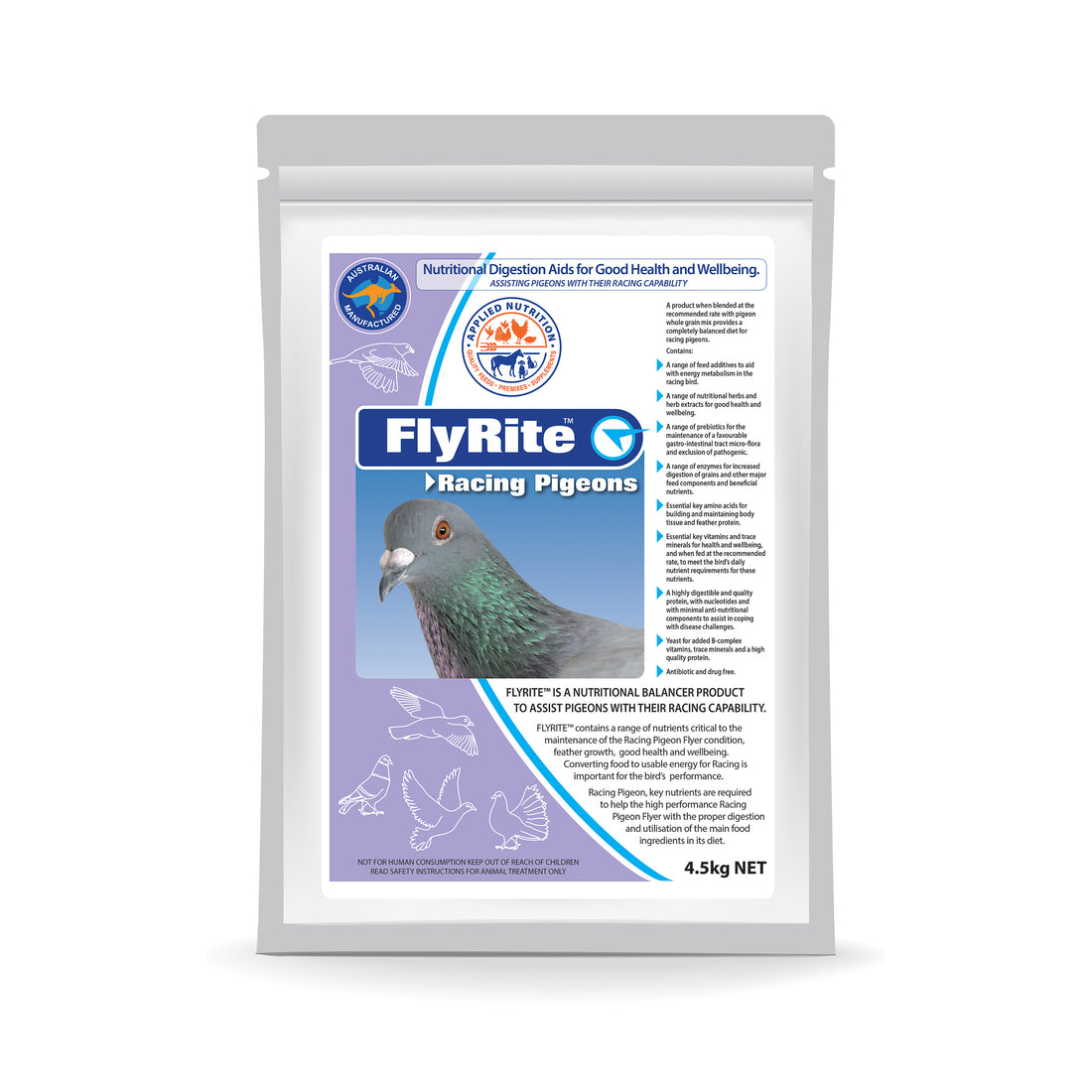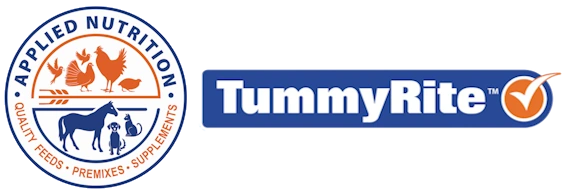
Feeding the High-Performance Racing Pigeon
The high-performance Racing Pigeon needs three major situations to operate if it has any chance of winning races in this highly competitive sport. These are:
Providing well balanced nutrition.
- Maintaining good health and wellbeing.
- Good Genetics and Training.
- Providing well-balanced nutrition.
Whilst the protein and amino acid requirements of pigeons are reasonably well known, my own observations have shown these requirements are rarely followed in practice resulting in diets which are poorly balanced, particularly when it comes to providing key essential amino acids for tissue repair and feather replacement. On many occasions I have observed excessively high levels of crude protein and fat in some pigeon diets. Whilst a level of 12% to 14% crude protein has been proposed as being ideal for racing pigeons, the balance of key essential amino acids is more important than protein per se. Keeping the protein level at the lower end of this range is important as any excess unusable protein must be broken down (deaminated) and excreted, and this costs energy. Energy that is not available for racing. Excessive amounts of unusable protein (nitrogen) can cause extra pressure on the kidneys and can adversely impact on racing performance. Unbalanced diets can affect body condition where insufficient balanced protein is available to build and maintain or repair muscles. Muscle condition and development is important for racing. Excessive and unbalanced protein can result in excessive fat deposition and lead to obesity.
A sound skeletal frame development is also important and therefore the pigeons will need a range of minerals such as calcium, phosphorus, electrolytes (sodium and potassium) and trace minerals to ensure proper skeletal development and body acid-base balance. Also, these minerals, such as calcium, phosphorus, electrolytes and trace minerals play an important role in other key metabolic processes. Calcium is grossly deficient in all of the grains usually fed to pigeons, and phosphorus is present in a phytate-bound form (70%) which has to be released in order to be available to the pigeon.
The solution to these issues is to formulate a dietary supplement that can balance the proteins from the seeds, unlock their energy and improve the overall bio-availability of the nutrients locked in the seeds. FLYRITE™ is the pigeon racing dietary supplement developed for this purpose and contains a range of vitamins, minerals, essential amino acids, and special ingredients that aid in digestion and energy metabolism within the pigeon. Racing pigeons that are fed properly will perform at their optimum.
- Maintaining Good Health and Well being.
disease challenges. Disease challenges are a constant threat to the racing pigeon. Sick pigeons do not perform or race well. Good quality protein and nucleotides are important for antibody production against diseases and other ingredients within the diet are needed to assist the pigeon to cope with disease challenges.
FLYRITE™ FOR PIGEONS contains a range of naturally occurring ingredients such yeast functional fibres, natural herb extracts, oregano, nucleotides and prebiotics to assist the pigeons to cope with disease challenges.
- Good Genetics and Training. Genetics and training play an important part in racing performance. These, combined with good nutrition and good health lead to optimum racing performance. Breeding and keeping pigeons from proven performance bloodlines is important for long term competitiveness. However, unlocking that genetic potential of racing performance can only be done by appropriate training associated with good nutrition and good health.
Definitions: Adenosine triphosphate (ATP) is a complex organic chemical that provides energy to drive many processes in living cells, e.g., muscle contraction, nerve impulse propagation, chemical synthesis. Found in all forms of life, ATP is often referred to as the “Molecular unit of currency” of intracellular energy transfer (see later). ADP Short for adenosine diphosphate. An organic compound that is composed of adenosine and two phosphate groups. With the addition of another phosphate group, it is converted to ATP for the storage of energy during cell metabolism.
When pigeons are racing, they are expending a large amount of energy. Mobilising this energy from sources within the body are achieved via several metabolic pathways. These are either aerobic processes which involve oxygen or anaerobic processes where oxygen is not involved. In the pigeon some carbohydrates (sugars and starches) are digested to glucose, absorbed, and subsequently stored in the muscles and liver as glycogen, which, in turn, is metabolised via the Citric acid cycle (Krebs’s cycle) and the electron-transport processes into ATP which is metabolised to ADP releasing energy. Aerobic processes are much more efficient and generate more energy per unit of glucose (36 moles of ATP from 1 mole of glucose) than anaerobic processes (1 mole glucose produces 2 moles of ATP). To this end, training plays a key role in lifting the “oxygen deficit limit” in the pigeon by improving fitness. In other words, the fitter the pigeon the longer it takes before the pigeon is limited by any oxygen deficiency.
The longer the pigeon can rely on aerobic processes to give it the energy to race, the better. Fat in the diet is digested into free fatty acids and then these free fatty acids are metabolised with oxygen yielding energy, water, carbon dioxide and heat. Depending on the carbon chain length of the specific fatty acid, one mole of a fatty acid when oxidised (aerobic process) can generate from 76 to 131 moles of ATP. There is significantly more energy (ATP) generated from 1 mole of Fatty acid than 1 mole of glucose. Therefore, for pigeons participating in long duration racing (>400km) fat metabolism plays a significant role as an energy fuel. Training helps the pigeon to keep this physiological process switched on.
When the pigeon is under intensive conditions requiring much energy, and insufficient oxygen is being input into the processes, anaerobic processes take over. Under anaerobic processes (no oxygen) less energy is released per unit of glucose and there is also a build-up of lactic acid in the muscles leading to muscle inflammation (myositis) and cramping (Walker, 2014). Training helps to develop muscle tone so that lactic acid can be removed more effectively by the circulation and subsequently the pigeon can exercise for longer periods without developing cramps or muscle inflammation (Walker, 2014). Our aim is to minimise anaerobic processes taking over to deliver energy to the pigeon. Training plays an important part in maintaining aerobic processes over anaerobic processes.
Training conditions the pigeon to switch on the important physiological triggers that allow for the mobilisation of fat and the freeing up of energy for muscle function once glycogen stores are depleted. Improving the capacity of the pigeon to store glycogen for those shorter distance races up to 400 km. Training is also important for the pigeon to build up its respiratory capacity so that energy is released from aerobic processes longer, i.e. lifting the “oxygen deficit limit” rather than anaerobic processes which generates less energy.
Like any athlete, to maximise the benefits from good nutrition, good health, and wellbeing, training is critical to the success of the competitive racing pigeon.
FLYRITE™ is a nutritional balancer product designed to assist Racing Pigeons to reach their racing capability. The product contains a range of nutrients critical to maintenance of the Racing Pigeon Flyer condition, feather growth and maintenance, good health and wellbeing. Converting food components into usable free energy for Racing is important for the optimum performance of the Racing Pigeon. Key additives such as exogenous enzymes assist the pigeon to digest the food components and neutralise the anti- nutritional carbohydrates such as non-starch polysaccharides (NSP). Basic food components such as sugars, starch and fats are then made freely available to the metabolic pathways to release free energy for the pigeon. The first step for the high-performance Racing Pigeon Flyer is proper digestion and utilisation of the main food ingredients in its diet.
The second step is to balance the protein coming from the main food ingredients to ensure the proper development and maintenance of tissues and feathers and to reduce excesses of unusable protein which costs energy to remove and therefore provides less energy for racing. FLYRITE™ contains a range of key essential amino acids and high-quality proteins, including nucleotides, to achieve this proper balance and aid with tissue repair and feather replacement during racing.
The third step is to aid the pigeon to cope with disease challenges it will encounter as it is mixed with other pigeons during the racing season. FLYRITE™ contains several natural ingredients, such as prebiotics, herb extracts, oregano, and yeast-functional fibres designed to increase and proliferate the number of favourable microflorae within the gastrointestinal tract (GIT). GIT health is critical to pigeon racing performance.
